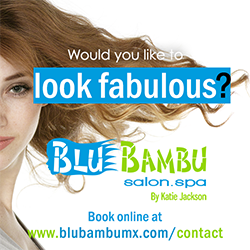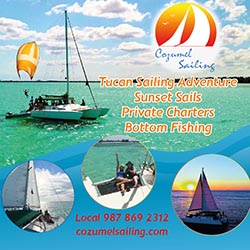Cozumel History
San Miguel Cozumel Readies for it’s 168th Anniversary
Monica Sauza Outlines Important Island History….

This upcoming November 21, San Miguel de Cozumel celebrates the 169th anniversary of its foundation.
Many events are involved in Cozumel’s history. In 1517 the Spaniards, who were already settled in Cuba (since 1492), decided to explore Cuba’s western waters. Caught in an unexpected storm, the explorers arrived to the coasts of the land now known as Yucatán.
Reasonably enough, the inhabitants were hostile and the explorers fled back to Cuba after this unsuccessful voyage. With news of the recently discovered land, native traders speaking about it and assuming gold would be found, the Spaniards organized a second expedition. On May 3, 1518 Juan de Grijalva arrived to Cozumel finding an empty town as the residents had fled into the jungle. Before carrying on with his exploration of the coastline of Yucatán, Grijalva baptized the Island as Santa Cruz de la Puerta Latina.
A year later a third expedition took place commanded by Hernán Cortés; however, two days before Cortés’ arrival, one of his captains, the short-tempered Pedro de Alvarado, had come ashore ransacking the town and the sanctuaries, and while most natives had fled into the jungle, a few were apprehended. Cortés ordered Alvarado to return the natives’ belongings and their release, but it goes without saying that he also ordered the destruction of all objects of worship placing the cross in their stead.
While in Cozumel, Cortés learned about two Spaniards who had survived the shipwreck of an early expedition (1510) living in the mainland; one of them, Jerónimo de Aguilar, became an essential element as interpreter through the inception of the Spaniards’ occupation of the New Spain which began in 1519, and lasted until 1821. As the Spaniards aimed to take over the territory of the New Spain on behalf of the Spanish crown, Francisco de Montejo, who had traveled along Grijalva in the 1518 expedition and later helped Cortés with the conquest, in 1526 was named the “Adelantado” (crown representative), Captain General and Chief Constable of Yucatán and Cozumel by royal decree and in 1527 was ordered to take possession of Cozumel naming it San Miguel de Xamancab.
As Cozumel fell under the jurisdiction of Yucatán and due to the tenacious conversion of the natives to the Catholic

Church by the Spaniards, an account tells us that by 1584 the then governor of Yucatán wrote a letter to the Spanish king saying that the natives were doing pilgrimages to Cozumel “to make vile sacrifices to their gods”. This brought about the evacuation of the Island’s population by royal decree. The uninhabited Island, visited only by pirates and corsairs, was repopulated on May 3rd. 1848 by families who fled the War of Castes in Yucatán, namely from Valladolid. Some versions say 16 were the original families, others 11 or 21.
These families founded el Cedral (Oy ib) on the south, and San Miguel to the northwest. Upon the request of these families, by 1849 the Government and Congress of Yucatán authorized the foundation of the town of San Miguel in honor of Archangel Michael, adopted as patron saint of the Island.
The Territory of Quintana Roo was created in 1935 by presidential decree and the then Governor, Rafael E. Melgar, eliminated the names of saints, thus the name of the Island remained only as Cozumel, as dictated by the 1975 Constitution of the Free and Sovereign State of Quintana Roo.
Happy Anniversary Cozumel!!!
San Miguel de Cozumel se prepara para su 168º aniversario
Por Monica Sauza

Este 21 de noviembre, San Miguel de Cozumel celebra el 168 aniversario de su fundación.
Son muchos los acontecimientos implicados en la historia de Cozumel. En el año 1517 los españoles, ya establecidos en Cuba (desde 1492), decidieron explorar sus aguas occidentales. Atrapados en una inesperada tormenta, los exploradores llegaron a las costas de las tierras que ahora se conocen como Yucatán.
Lógicamente, los habitantes eran hostiles por lo que los exploradores huyeron de regreso a Cuba después de este fallido viaje. Con las noticias de la tierra recién descubierta, de los comerciantes indígenas quienes hablaban acerca de ésta y suponiendo que encontrarían oro, los españoles organizaron una segunda expedición. El 3 de mayo del año 1518, Juan de Grijalva llegó a Cozumel encontrándose con un poblado vacío pues los pobladores habían huido hacia la jungla. Antes de continuar su exploración de las costas de Yucatán, Grijalva bautizó a la Isla con el nombre Santa Cruz de la Puerta Latina. Un año después se llevó a cabo una tercera expedición al mando de Hernán Cortés; sin embargo, dos días antes de su llegada, uno de sus capitanes, el irascible Pedro de Alvarado, había bajado a tierra firme saqueando el pueblo y los santuarios, y a pesar de que la mayoría de los pobladores habían huido hacia la jungla, algunos fueron apresados. Cortés ordenó a Alvarado que regresara las pertenencias de los pobladores así como su liberación, pero huelga decir que también ordeno la destrucción de todos los objetos de adoración colocando la cruz en lugar de éstos.
Durante su estadía en Cozumel, Cortés se enteró de la existencia de dos españoles sobrevivientes del naufragio de

una expedición anterior (1510) quienes vivían en tierra firme. Uno de ellos, Jerónimo de Aguilar, se convirtió en un elemento esencial como intérprete durante el comienzo de la ocupación española en la Nueva España que inició en 1519 y duró hasta 1821. Como el propósito de los españoles era dominar el territorio de la Nueva España a nombre de la corona española, Francisco de Montejo, quien viajó con Grijalva en la expedición de 1518 y después ayudó a Cortés en la conquista, por decreto real en 1526 fue nombrado el “Adelantado” (representante de la corona), Capital General y Alguacil Mayor de Yucatán Y Cozumel, y para el año 1527 le fue ordenado tomar posesión de Cozumel dándole el nombre de San Miguel de Xamancab. Como Cozumel se encontraba dentro de la jurisdicción de Yucatán y en virtud de la férrea conversión de los indígenas por parte de los españoles a la iglesia católica, una relación cuenta que en 1548 el entonces gobernador de Yucatán escribió una carta al rey español señalando que los indígenas hacían peregrinajes a Cozumel, para “realizar malvados sacrificios a sus dioses”. Esto trajo como resultado el desalojo de la población de la Isla por decreto real.
La Isla deshabitada, visitada sólo por piratas y corsarios, fue repoblada el 3 de Mayo de 1848 por familias que huían de la Guerra de Castas que ocurría en Yucatán, principalmente en Valladolid. Algunas versiones dicen que las familias originales fueron 16, otras versiones hablan de 11 o 21.
Estas familias fundaron el Cedral (Oy ib) al sur, y San Miguel al noroeste. A solicitud de estas familias en el año de 1849 el Gobierno y Congreso de Yucatán autoriza la fundación del poblado de San Miguel en honor al Arcángel Miguel, adoptado como santo patrono de la Isla. Por decreto presidencial en el año 1935 se crea el Territorio de Quintana Roo y el entonces Gobernador, Rafael E. Melgar, eliminó los nombres de santos; de ahí que el nombre de la Isla prevalecería sólo como Cozumel, tal como lo marca la Constitución de 1975 del Estado Libre y Soberano de Quintana Roo.
¡Feliz Aniversario Cozumel!
Otra fugitiva de la Ciudad de México. Mónica ha hecho de Cozumel su hogar definitivo. Desde su llegada en 1981, trabajo en turismo en todos los lugares habituales: hoteles, buceo, aeropuerto, ferries, hasta que se abrió la oportunidad de desempeñarse en su campo. Desde finales de la década de los años 70 Mónica ha estado traduciendo e interpretando, dedicándose plenamente a ello a partir de 1998, y ha asistido a extranjeros y locales de la Isla a establecer su residencia y sus negocios. Es traductora con gran experiencia, ávida historiadora y una gran fuente de tradiciones y leyendas locales.
- Mexican History 3 Kings Day - January 8, 2025
- 2025 Mexican National Holidays - January 3, 2025
- Mayan Weather Predictions - January 2, 2025
Another escapee from Mexico City, Monica has made Cozumel her definite home. Since her arrival -in 981- she worked in tourism in all the usual venues: hotels, scuba diving, airport, ferries, until the opportunity to practice in her chosen field grew. Since the latter part of the 70s Monica has been translating and interpreting, fully devoting herself to it since 1998, and has assisted foreigners and Island residents establish residence and businesses- She is a Translator with extensive experience, an avid historian and a great source of local lore and legends. Otra fugitiva de la Ciudad de México. Mónica ha hecho de Cozumel su hogar definitivo. Desde su llegada en 1981, trabajo en turismo en todos los lugares habituales: hoteles, buceo, aeropuerto, ferries, hasta que se abrió la oportunidad de desempeñarse en su campo. Desde finales de la década de los años 70 Mónica ha estado traduciendo e interpretando, dedicándose plenamente a ello a partir de 1998, y ha asistido a extranjeros y locales de la Isla a establecer su residencia y sus negocios. Es traductora con gran experiencia, ávida historiadora y una gran fuente de tradiciones y leyendas locales.
1 Comment
Leave a Reply Cancel reply
Cozumel Museum
Cozumel Museum Cozumel’s “Museo de la Isla” Celebrates 38 Years Cozumel’s...
Feria Cedral Schedule
Feria Cedral Schedule La Feria de El Cedral & La Fiesta...
Cozumel Punta Sur Road Repair
Cozumel Punta Sur Road Repair Cozumel’s Punta Sur Road to Have...
Mexican History 3 Kings Day
Mexican History 3 Kings Day The Significance of January 6th & February...





















I read the history of cozumel as presented by you , its a very interest account of its history , how ever as it is well kn own that history veries according to its source .there is no mention of the chronicles of conquest by andres de Tapia who wrote about the finding of a cross made of lime at the foot of an idol tower that was estimated to have a height of an estado y medio ,approx 8 to 9 feet tall , also l have read that Cuba was not conquered and colonize until 1510 or 1511 maybe you may want to check this out .